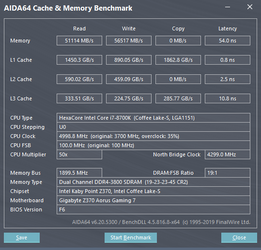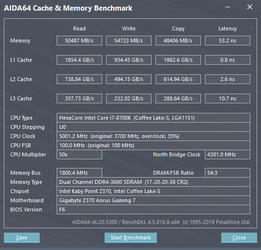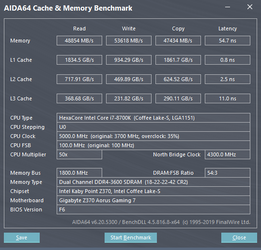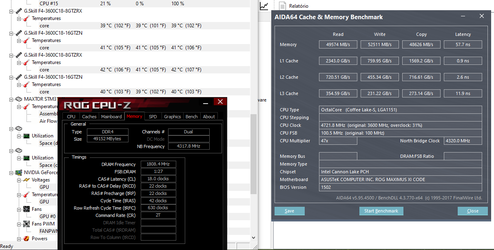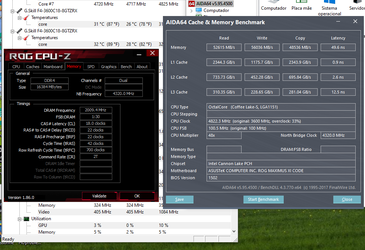Hi all, new member here, simply googling my memory and the query term "overclocking" has resulted in no hits other than Woomack's OC review of the 16GB variant of this memory (I presume, same timings).
https://www.overclockers.com/forums...Royal-2x8GB-DDR4-3600-CL18-F4-3600C18D-16GTRS
Anyhow, it's stable under XMP, timings are a bit higher than I'd like, any recommendations as to where to start to try to OC these bad boys a little?
F4-3600C18D-32GTRS
Trident Z Royal
DDR4-3600MHz CL18-22-22-42 1.35V
32GB (2x16GB)
I love the way they look but I primarily got them after much research and coming to the conclusion that pushing for 4000Mhz+ with my motherboard is extremely difficult as it has single phase DRAM VRM (Gigabyte Z370 Aorus Gaming 7). The web is littered with posts of people complaining about not being able to attain 4000 MHz+ even at 1.45v+ with this particular board. So knowing that, and seeing a few comparison videos showing the gains to be had simply going from 16 to 32GB of memory with the same freq and timings I decided to upgrade from my previous memory: F4-3200C16D-16GTZR (3200MHz CL16-18-18-38 1.35V) based on a 3200 MHz CL16 vs 3600 MHz CL18 video.
I figured there was some performance to be gained here and this would be about as good as it gets without spending a few hundred dollars more upgrading the motherboard to something with better DRAM VRM.
16GB vs 32GB
3200 MHz CL16 vs 3600 MHz CL18
I just ran Firestrike and although I wasn't expecting a gain in per-se in the Physics test I was surprised to see the CL18 3600 MHz memory run just slightly slower here, although the difference is too close and could be attributed to how variable this benchmark can be (I can run the same benchmark back to back with same temps and have Physics score vary by 50-100 points or more).
https://www.3dmark.com/compare/fs/21916785/fs/21849156
I know that this is not the benchmark to gauge memory performance, it's just that the last time I tried upgrading the former memory (without success, it wasn't stable ultimately) from 3200 to 3466 MHz I did actually pick up a few hundred points in Firestrike Physics test.
I intend to run Cinebinch R15 and Aida64 later.
I can't find anything pertaining to overclocking this memory, I would be extremely grateful for any help with this.
Thanks in advance!
Post script:
I forgot to add that this memory is on the G.Skill's updated QVL for this motherboard.
https://www.overclockers.com/forums...Royal-2x8GB-DDR4-3600-CL18-F4-3600C18D-16GTRS
Anyhow, it's stable under XMP, timings are a bit higher than I'd like, any recommendations as to where to start to try to OC these bad boys a little?
F4-3600C18D-32GTRS
Trident Z Royal
DDR4-3600MHz CL18-22-22-42 1.35V
32GB (2x16GB)
I love the way they look but I primarily got them after much research and coming to the conclusion that pushing for 4000Mhz+ with my motherboard is extremely difficult as it has single phase DRAM VRM (Gigabyte Z370 Aorus Gaming 7). The web is littered with posts of people complaining about not being able to attain 4000 MHz+ even at 1.45v+ with this particular board. So knowing that, and seeing a few comparison videos showing the gains to be had simply going from 16 to 32GB of memory with the same freq and timings I decided to upgrade from my previous memory: F4-3200C16D-16GTZR (3200MHz CL16-18-18-38 1.35V) based on a 3200 MHz CL16 vs 3600 MHz CL18 video.
I figured there was some performance to be gained here and this would be about as good as it gets without spending a few hundred dollars more upgrading the motherboard to something with better DRAM VRM.
16GB vs 32GB
3200 MHz CL16 vs 3600 MHz CL18
I just ran Firestrike and although I wasn't expecting a gain in per-se in the Physics test I was surprised to see the CL18 3600 MHz memory run just slightly slower here, although the difference is too close and could be attributed to how variable this benchmark can be (I can run the same benchmark back to back with same temps and have Physics score vary by 50-100 points or more).
https://www.3dmark.com/compare/fs/21916785/fs/21849156
I know that this is not the benchmark to gauge memory performance, it's just that the last time I tried upgrading the former memory (without success, it wasn't stable ultimately) from 3200 to 3466 MHz I did actually pick up a few hundred points in Firestrike Physics test.
I intend to run Cinebinch R15 and Aida64 later.
I can't find anything pertaining to overclocking this memory, I would be extremely grateful for any help with this.
Thanks in advance!
Post script:
I forgot to add that this memory is on the G.Skill's updated QVL for this motherboard.
Last edited:
